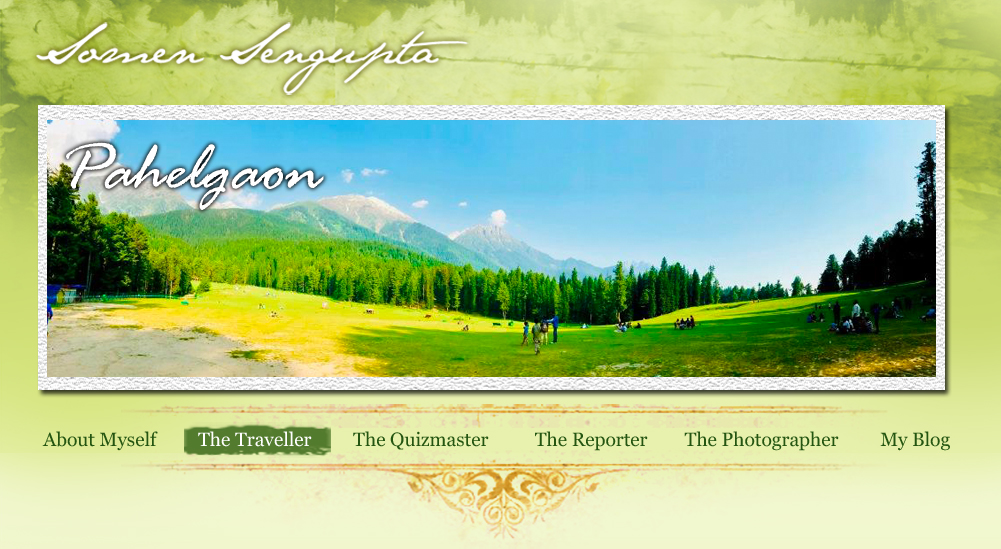| PAHELGAON THE LAND OF SPLENDID PANORAMA |
|
Snow capped peaks combined with lush landscapes truly make this scenic village a jewel in the crown of Kashmir
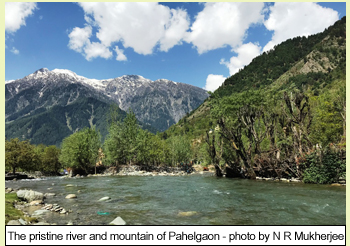 Leaving the majestic Dal Lake behind in Srinagar, my car took a turn towards Pampur on the way to a boundless land of beauty. At Srinagar itself, it was clearly settled with the taxi driver that he will not waste time as I needed to reach Pahelgaon early. I had a secret wish to stop at Pampur because Spain as a destination was looking far too difficult to visit in order to see saffron being grown, since it is found in only two places in the world. However, with no regret the plan was nipped as Pahelgaon was calling. While I was gliding in the green and brown rocky surface of the Himalayas, nature was surprising us at every turn. The valley of Kashmir with its snow-capped peaks and green landscape was better than what I imagined. Being a sunny day, every colour was clear and the dewdrops were shining off the leaves and blades of grass, justifying the title of the region as “Queen of Kashmir.” In that sea of beauty, it occurred to me that Kashmir was once a country of demons according to Hindu mythology. The myth calls Kashmir Satisar meaning, “the lake of sati and kingdom of demons.” Then Maharishi Kashyap arrived, killing the demons and freeing the suppressed subjects of the land.
Leaving the majestic Dal Lake behind in Srinagar, my car took a turn towards Pampur on the way to a boundless land of beauty. At Srinagar itself, it was clearly settled with the taxi driver that he will not waste time as I needed to reach Pahelgaon early. I had a secret wish to stop at Pampur because Spain as a destination was looking far too difficult to visit in order to see saffron being grown, since it is found in only two places in the world. However, with no regret the plan was nipped as Pahelgaon was calling. While I was gliding in the green and brown rocky surface of the Himalayas, nature was surprising us at every turn. The valley of Kashmir with its snow-capped peaks and green landscape was better than what I imagined. Being a sunny day, every colour was clear and the dewdrops were shining off the leaves and blades of grass, justifying the title of the region as “Queen of Kashmir.” In that sea of beauty, it occurred to me that Kashmir was once a country of demons according to Hindu mythology. The myth calls Kashmir Satisar meaning, “the lake of sati and kingdom of demons.” Then Maharishi Kashyap arrived, killing the demons and freeing the suppressed subjects of the land. 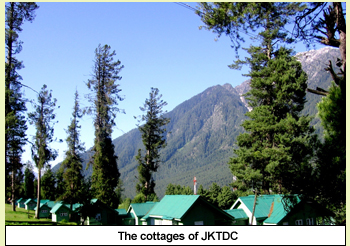 From the word Kashyapmari meaning, “killed in the hand of Kashyap,” the word Kashmir originated. My captivated mood was pleasantly broken when after crossing several hair-pin bends, our car stopped at Avantipur near the archaeological ruins of two Hindu temples. History quickly reminded me that before King Prabar Sen shifted it to Srinagar, this was the capital of ancient Kashmir. It may seem difficult to believe that Kashmir was once a land of Hindu people ruled by several Hindu dynasties for centuries from which music to archaeology originated and enriched the culture with distinctive merit and skill. From the word Kashyapmari meaning, “killed in the hand of Kashyap,” the word Kashmir originated. My captivated mood was pleasantly broken when after crossing several hair-pin bends, our car stopped at Avantipur near the archaeological ruins of two Hindu temples. History quickly reminded me that before King Prabar Sen shifted it to Srinagar, this was the capital of ancient Kashmir. It may seem difficult to believe that Kashmir was once a land of Hindu people ruled by several Hindu dynasties for centuries from which music to archaeology originated and enriched the culture with distinctive merit and skill.
The relic of one such legacy is the temple of Avatiswamin dedicated to Vaikuntha Vishnu and the other is Avatisiswar dedicated to Shiva. Both were built by Lalitaditya the great Hindu king of Kashmir during 855 to 883 AD. Standing on the banks of the beautiful River Jhelum also known as Vitasta, are the temples that were named after Avantiverman, thefounder of the Utkal dynasty. Legend has it, that these temples were built by the Pandavas of The Mahabharata. As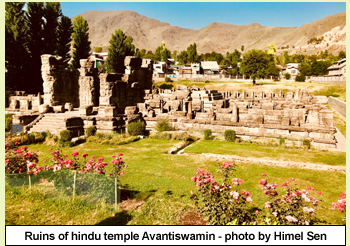 I entered the temple compound of Avantiswamin, I quickly realised that the present ruin is not even a shadow of the original temple. However the ruins itself are a strong testimony of unimaginative engineering skill, executed several centuries ago. The roofless blue and grey sandstone temple has a central courtyard and is surrounded by colonnaded pillars richly decorated with motifs and statues. The Buddhist influence is evident in the paved courtyard having an outer boundary, housing four smaller shrines at its four corners. I entered the temple compound of Avantiswamin, I quickly realised that the present ruin is not even a shadow of the original temple. However the ruins itself are a strong testimony of unimaginative engineering skill, executed several centuries ago. The roofless blue and grey sandstone temple has a central courtyard and is surrounded by colonnaded pillars richly decorated with motifs and statues. The Buddhist influence is evident in the paved courtyard having an outer boundary, housing four smaller shrines at its four corners.
When I finally reached Pahelgaon in the afternoon, it was drizzling. My co-passengers explained that Pahelgaon means “the first village.” So I opened my guide book to note that from Zoji La pass via Ladakh, this was once the first village on the way to the Amarnath caves. Even today, the pilgrimage to Amarnath begins from Pahelgaon. I had no plans to 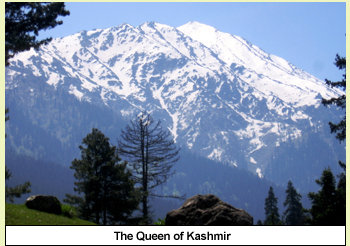 visit Amarnath and this did not make my driver happy. He insisted that for a Hindu, this was a golden opportunity and that I must grab it. In a place like Pahelgaon, one does not need to grab anything because he is grabbed by the magical serenity, and I was no exception as well. The blue sky which was overcast gradually brightened to give way to sunlight which reflected off the snow white peaks and the green valley. The tourist cottages of Kashmir Tourismsurrounded by Pine and Oak trees, made me feel like I was in a quaint European country. After lunch, I decided to take a walk along the green banks of the River Lidder which flowed like liquid glass. I was told not be over-adventurous near any river, which is beautiful- until your life is in danger. I found a rock mass big enough to rest my body, but not my soul. The cool winds from the Himalayas were blowing and the sound of the water became thrilling and mystic. It was finally so loud that at one point of time, even a whisper was not audible. Soon, a magical evening unfolded on the banks of the River Lidder. A full moon reflected in the water, adding a kind of necromancy to the clandestine. It was cold and isolated and the valley of Pahelgaon was blooming with a pure and primitive aura. The next morning, I arrived at the greenest part of Pahelgaon, known as the Betab Valley — named after a movie which was shot there in 1982 to 1983. This is also incorrectly called “poor man’s Switzerland.” I was in disagreement, as I did not find any deficiency of Pahelgaon as far as the landscape is concerned. visit Amarnath and this did not make my driver happy. He insisted that for a Hindu, this was a golden opportunity and that I must grab it. In a place like Pahelgaon, one does not need to grab anything because he is grabbed by the magical serenity, and I was no exception as well. The blue sky which was overcast gradually brightened to give way to sunlight which reflected off the snow white peaks and the green valley. The tourist cottages of Kashmir Tourismsurrounded by Pine and Oak trees, made me feel like I was in a quaint European country. After lunch, I decided to take a walk along the green banks of the River Lidder which flowed like liquid glass. I was told not be over-adventurous near any river, which is beautiful- until your life is in danger. I found a rock mass big enough to rest my body, but not my soul. The cool winds from the Himalayas were blowing and the sound of the water became thrilling and mystic. It was finally so loud that at one point of time, even a whisper was not audible. Soon, a magical evening unfolded on the banks of the River Lidder. A full moon reflected in the water, adding a kind of necromancy to the clandestine. It was cold and isolated and the valley of Pahelgaon was blooming with a pure and primitive aura. The next morning, I arrived at the greenest part of Pahelgaon, known as the Betab Valley — named after a movie which was shot there in 1982 to 1983. This is also incorrectly called “poor man’s Switzerland.” I was in disagreement, as I did not find any deficiency of Pahelgaon as far as the landscape is concerned.
The scenic vista was unmatched as I looked at the splendid green pastures in the horizon where it finally met the boundary of dark, wooded pine and chinar. Mist and clouds covered the forest, and just above them, snow-capped peaks smiled regally. Walking on the green, soft grass carpet of the Betab valley, I cleared a doubt from my mind. Returning from Pahelgaon calmed my perplexing mind which always questioned why no one wants to part with Kashmir. I finally knew the answer is found in Pahelgaon
Note - Mast and icon photo is contributed by Himel Sen
This article was published in The Statesman on 8th July 2018
Click here to view the original article
|
